RMIT Administer and Monitor Medicines Assessment - Online
VerifiedAdded on 2023/01/07
|27
|7477
|79
Homework Assignment
AI Summary
This document presents a comprehensive medication administration assessment completed by a student at RMIT University, focusing on the "Administer and monitor medicines and Intravenous therapy" unit. The assessment includes true or false questions, short answer questions, and table-based responses. The student demonstrates understanding of government regulations, medication schedules, drug calculations, the differences between pharmacodynamics and pharmacokinetics, pharmacotherapeutics, and nursing considerations for NSAID and antacid administration. The assessment covers key aspects of pharmacology, medication safety, and patient care, providing a valuable resource for nursing students. The student's responses cover topics such as medication storage, drug calculations, and potential side effects, offering a thorough overview of the subject matter. This assignment is designed to assess the student's knowledge and ability to apply it in a practical context, ensuring competency in medication administration.
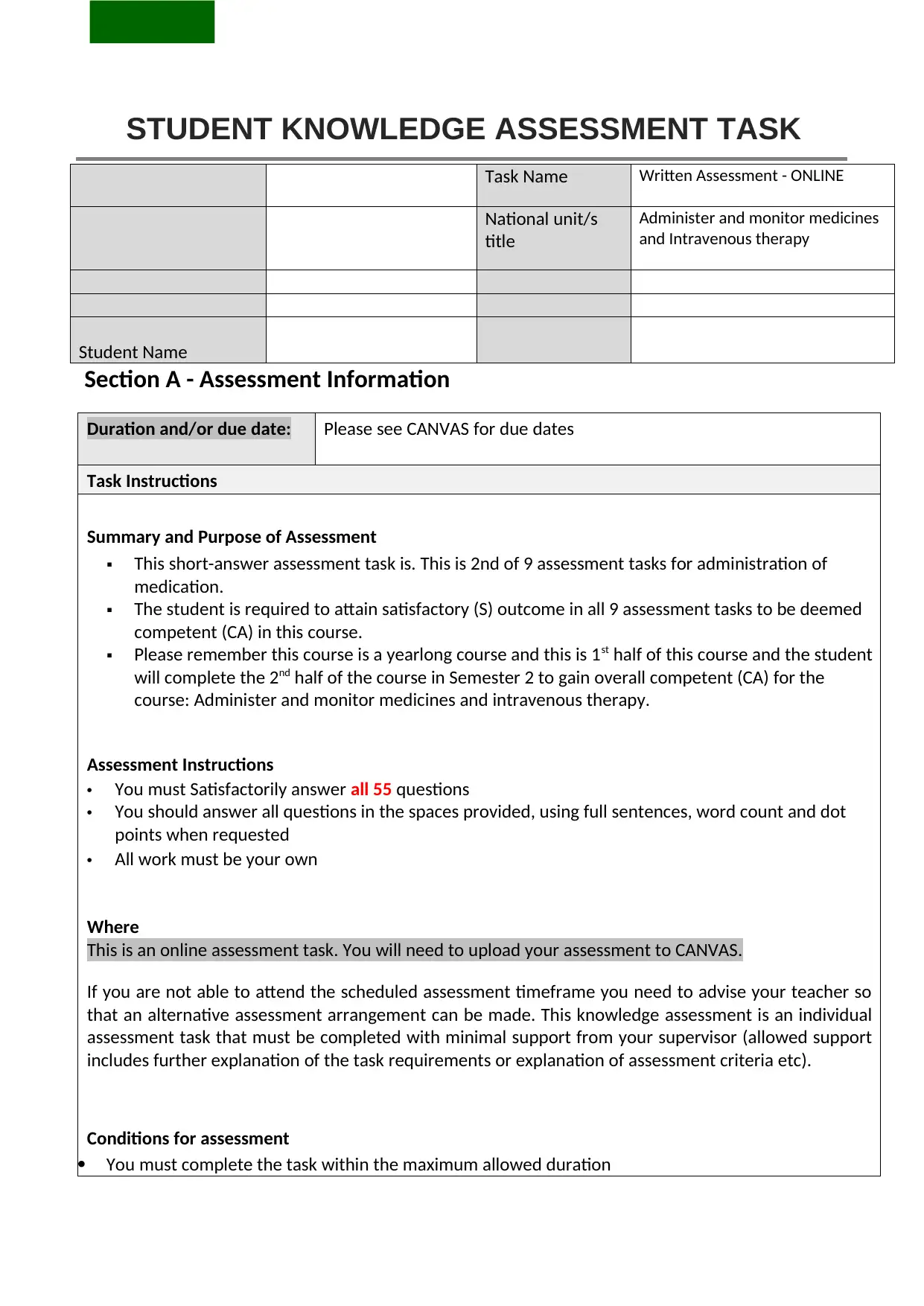
STUDENT KNOWLEDGE ASSESSMENT TASK
Task Name Written Assessment - ONLINE
National unit/s
title
Administer and monitor medicines
and Intravenous therapy
Student Name
Section A - Assessment Information
Duration and/or due date: Please see CANVAS for due dates
Task Instructions
Summary and Purpose of Assessment
This short-answer assessment task is. This is 2nd of 9 assessment tasks for administration of
medication.
The student is required to attain satisfactory (S) outcome in all 9 assessment tasks to be deemed
competent (CA) in this course.
Please remember this course is a yearlong course and this is 1st half of this course and the student
will complete the 2nd half of the course in Semester 2 to gain overall competent (CA) for the
course: Administer and monitor medicines and intravenous therapy.
Assessment Instructions
• You must Satisfactorily answer all 55 questions
• You should answer all questions in the spaces provided, using full sentences, word count and dot
points when requested
• All work must be your own
Where
This is an online assessment task. You will need to upload your assessment to CANVAS.
If you are not able to attend the scheduled assessment timeframe you need to advise your teacher so
that an alternative assessment arrangement can be made. This knowledge assessment is an individual
assessment task that must be completed with minimal support from your supervisor (allowed support
includes further explanation of the task requirements or explanation of assessment criteria etc).
Conditions for assessment
You must complete the task within the maximum allowed duration
Task Name Written Assessment - ONLINE
National unit/s
title
Administer and monitor medicines
and Intravenous therapy
Student Name
Section A - Assessment Information
Duration and/or due date: Please see CANVAS for due dates
Task Instructions
Summary and Purpose of Assessment
This short-answer assessment task is. This is 2nd of 9 assessment tasks for administration of
medication.
The student is required to attain satisfactory (S) outcome in all 9 assessment tasks to be deemed
competent (CA) in this course.
Please remember this course is a yearlong course and this is 1st half of this course and the student
will complete the 2nd half of the course in Semester 2 to gain overall competent (CA) for the
course: Administer and monitor medicines and intravenous therapy.
Assessment Instructions
• You must Satisfactorily answer all 55 questions
• You should answer all questions in the spaces provided, using full sentences, word count and dot
points when requested
• All work must be your own
Where
This is an online assessment task. You will need to upload your assessment to CANVAS.
If you are not able to attend the scheduled assessment timeframe you need to advise your teacher so
that an alternative assessment arrangement can be made. This knowledge assessment is an individual
assessment task that must be completed with minimal support from your supervisor (allowed support
includes further explanation of the task requirements or explanation of assessment criteria etc).
Conditions for assessment
You must complete the task within the maximum allowed duration
Paraphrase This Document
Need a fresh take? Get an instant paraphrase of this document with our AI Paraphraser
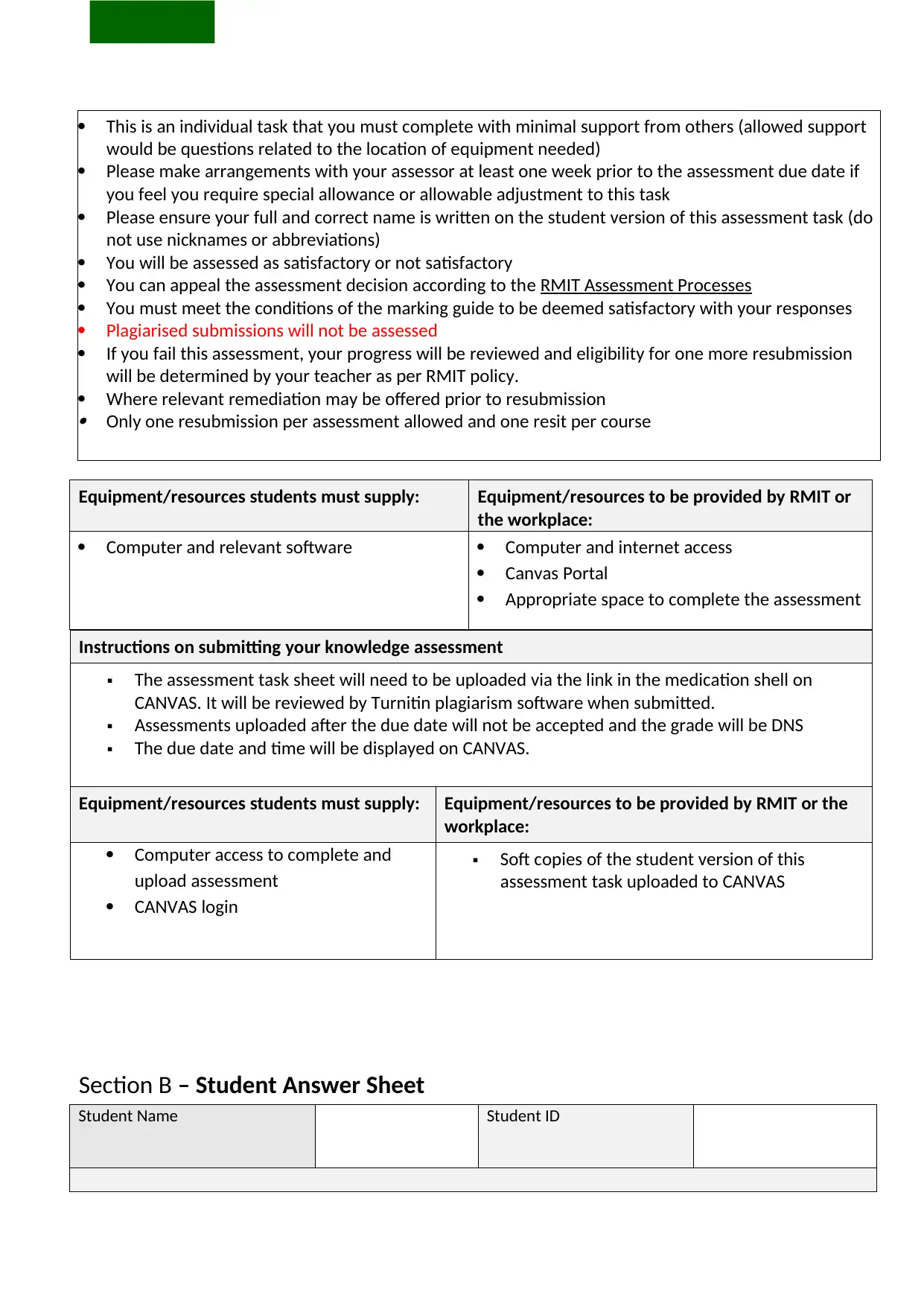
This is an individual task that you must complete with minimal support from others (allowed support
would be questions related to the location of equipment needed)
Please make arrangements with your assessor at least one week prior to the assessment due date if
you feel you require special allowance or allowable adjustment to this task
Please ensure your full and correct name is written on the student version of this assessment task (do
not use nicknames or abbreviations)
You will be assessed as satisfactory or not satisfactory
You can appeal the assessment decision according to the RMIT Assessment Processes
You must meet the conditions of the marking guide to be deemed satisfactory with your responses
Plagiarised submissions will not be assessed
If you fail this assessment, your progress will be reviewed and eligibility for one more resubmission
will be determined by your teacher as per RMIT policy.
Where relevant remediation may be offered prior to resubmission Only one resubmission per assessment allowed and one resit per course
Equipment/resources students must supply: Equipment/resources to be provided by RMIT or
the workplace:
Computer and relevant software Computer and internet access
Canvas Portal
Appropriate space to complete the assessment
Instructions on submitting your knowledge assessment
The assessment task sheet will need to be uploaded via the link in the medication shell on
CANVAS. It will be reviewed by Turnitin plagiarism software when submitted.
Assessments uploaded after the due date will not be accepted and the grade will be DNS
The due date and time will be displayed on CANVAS.
Equipment/resources students must supply: Equipment/resources to be provided by RMIT or the
workplace:
Computer access to complete and
upload assessment
CANVAS login
Soft copies of the student version of this
assessment task uploaded to CANVAS
Section B – Student Answer Sheet
Student Name Student ID
would be questions related to the location of equipment needed)
Please make arrangements with your assessor at least one week prior to the assessment due date if
you feel you require special allowance or allowable adjustment to this task
Please ensure your full and correct name is written on the student version of this assessment task (do
not use nicknames or abbreviations)
You will be assessed as satisfactory or not satisfactory
You can appeal the assessment decision according to the RMIT Assessment Processes
You must meet the conditions of the marking guide to be deemed satisfactory with your responses
Plagiarised submissions will not be assessed
If you fail this assessment, your progress will be reviewed and eligibility for one more resubmission
will be determined by your teacher as per RMIT policy.
Where relevant remediation may be offered prior to resubmission Only one resubmission per assessment allowed and one resit per course
Equipment/resources students must supply: Equipment/resources to be provided by RMIT or
the workplace:
Computer and relevant software Computer and internet access
Canvas Portal
Appropriate space to complete the assessment
Instructions on submitting your knowledge assessment
The assessment task sheet will need to be uploaded via the link in the medication shell on
CANVAS. It will be reviewed by Turnitin plagiarism software when submitted.
Assessments uploaded after the due date will not be accepted and the grade will be DNS
The due date and time will be displayed on CANVAS.
Equipment/resources students must supply: Equipment/resources to be provided by RMIT or the
workplace:
Computer access to complete and
upload assessment
CANVAS login
Soft copies of the student version of this
assessment task uploaded to CANVAS
Section B – Student Answer Sheet
Student Name Student ID
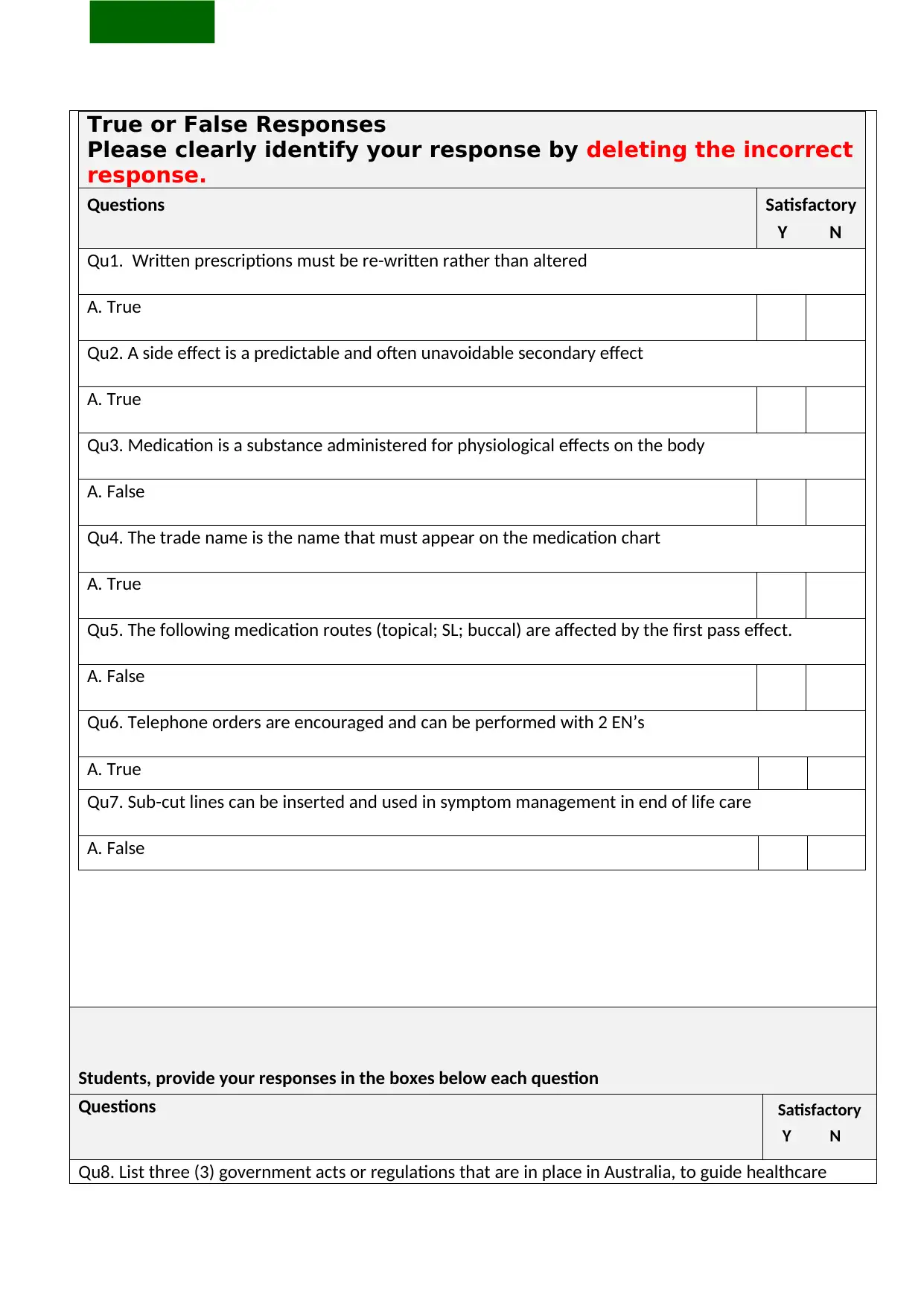
True or False Responses
Please clearly identify your response by deleting the incorrect
response.
Questions Satisfactory
Y N
Qu1. Written prescriptions must be re-written rather than altered
A. True
Qu2. A side effect is a predictable and often unavoidable secondary effect
A. True
Qu3. Medication is a substance administered for physiological effects on the body
A. False
Qu4. The trade name is the name that must appear on the medication chart
A. True
Qu5. The following medication routes (topical; SL; buccal) are affected by the first pass effect.
A. False
Qu6. Telephone orders are encouraged and can be performed with 2 EN’s
A. True
Qu7. Sub-cut lines can be inserted and used in symptom management in end of life care
A. False
Students, provide your responses in the boxes below each question
Questions Satisfactory
Y N
Qu8. List three (3) government acts or regulations that are in place in Australia, to guide healthcare
Please clearly identify your response by deleting the incorrect
response.
Questions Satisfactory
Y N
Qu1. Written prescriptions must be re-written rather than altered
A. True
Qu2. A side effect is a predictable and often unavoidable secondary effect
A. True
Qu3. Medication is a substance administered for physiological effects on the body
A. False
Qu4. The trade name is the name that must appear on the medication chart
A. True
Qu5. The following medication routes (topical; SL; buccal) are affected by the first pass effect.
A. False
Qu6. Telephone orders are encouraged and can be performed with 2 EN’s
A. True
Qu7. Sub-cut lines can be inserted and used in symptom management in end of life care
A. False
Students, provide your responses in the boxes below each question
Questions Satisfactory
Y N
Qu8. List three (3) government acts or regulations that are in place in Australia, to guide healthcare
⊘ This is a preview!⊘
Do you want full access?
Subscribe today to unlock all pages.

Trusted by 1+ million students worldwide
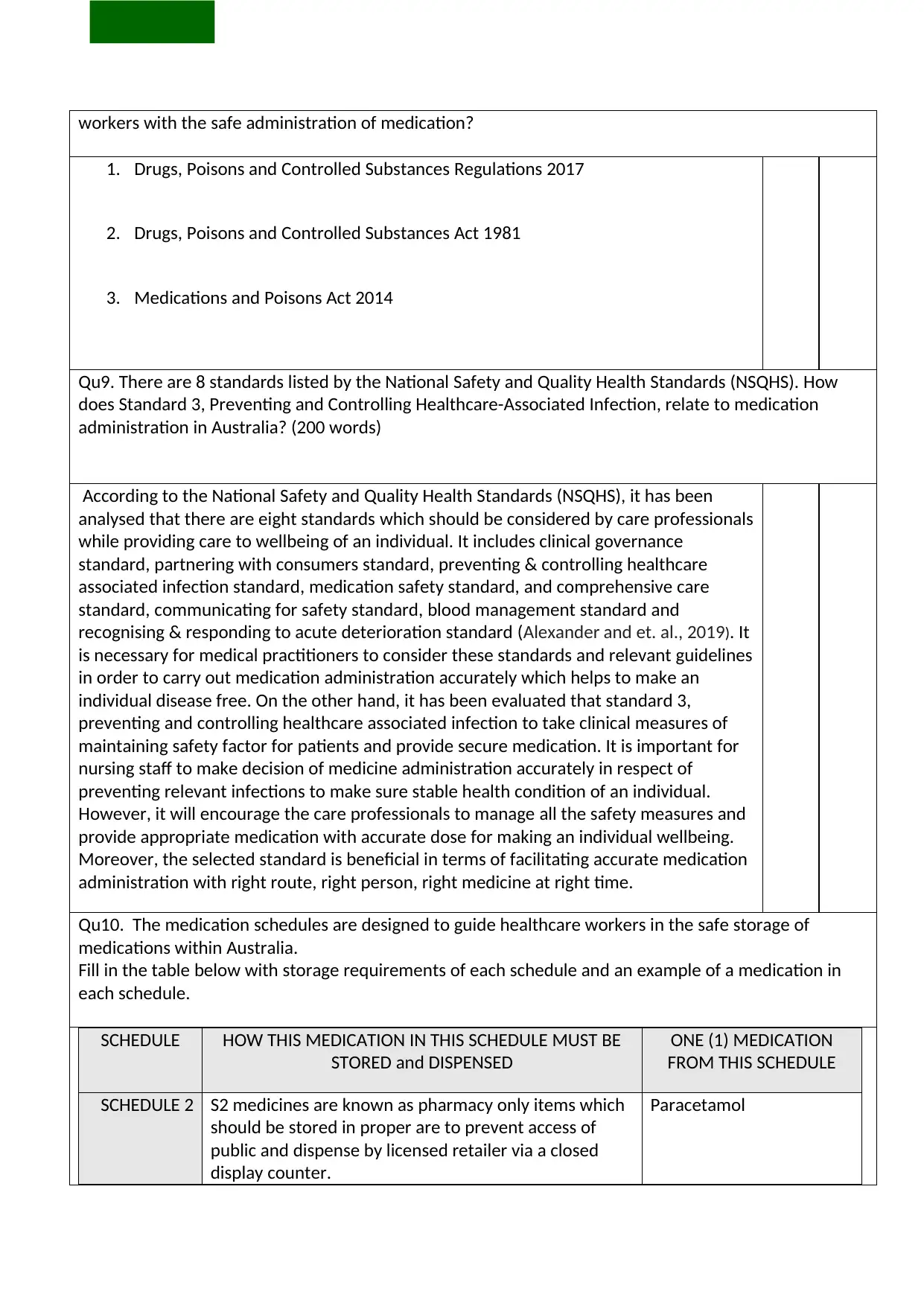
workers with the safe administration of medication?
1. Drugs, Poisons and Controlled Substances Regulations 2017
2. Drugs, Poisons and Controlled Substances Act 1981
3. Medications and Poisons Act 2014
Qu9. There are 8 standards listed by the National Safety and Quality Health Standards (NSQHS). How
does Standard 3, Preventing and Controlling Healthcare-Associated Infection, relate to medication
administration in Australia? (200 words)
According to the National Safety and Quality Health Standards (NSQHS), it has been
analysed that there are eight standards which should be considered by care professionals
while providing care to wellbeing of an individual. It includes clinical governance
standard, partnering with consumers standard, preventing & controlling healthcare
associated infection standard, medication safety standard, and comprehensive care
standard, communicating for safety standard, blood management standard and
recognising & responding to acute deterioration standard (Alexander and et. al., 2019). It
is necessary for medical practitioners to consider these standards and relevant guidelines
in order to carry out medication administration accurately which helps to make an
individual disease free. On the other hand, it has been evaluated that standard 3,
preventing and controlling healthcare associated infection to take clinical measures of
maintaining safety factor for patients and provide secure medication. It is important for
nursing staff to make decision of medicine administration accurately in respect of
preventing relevant infections to make sure stable health condition of an individual.
However, it will encourage the care professionals to manage all the safety measures and
provide appropriate medication with accurate dose for making an individual wellbeing.
Moreover, the selected standard is beneficial in terms of facilitating accurate medication
administration with right route, right person, right medicine at right time.
Qu10. The medication schedules are designed to guide healthcare workers in the safe storage of
medications within Australia.
Fill in the table below with storage requirements of each schedule and an example of a medication in
each schedule.
SCHEDULE HOW THIS MEDICATION IN THIS SCHEDULE MUST BE
STORED and DISPENSED
ONE (1) MEDICATION
FROM THIS SCHEDULE
SCHEDULE 2 S2 medicines are known as pharmacy only items which
should be stored in proper are to prevent access of
public and dispense by licensed retailer via a closed
display counter.
Paracetamol
1. Drugs, Poisons and Controlled Substances Regulations 2017
2. Drugs, Poisons and Controlled Substances Act 1981
3. Medications and Poisons Act 2014
Qu9. There are 8 standards listed by the National Safety and Quality Health Standards (NSQHS). How
does Standard 3, Preventing and Controlling Healthcare-Associated Infection, relate to medication
administration in Australia? (200 words)
According to the National Safety and Quality Health Standards (NSQHS), it has been
analysed that there are eight standards which should be considered by care professionals
while providing care to wellbeing of an individual. It includes clinical governance
standard, partnering with consumers standard, preventing & controlling healthcare
associated infection standard, medication safety standard, and comprehensive care
standard, communicating for safety standard, blood management standard and
recognising & responding to acute deterioration standard (Alexander and et. al., 2019). It
is necessary for medical practitioners to consider these standards and relevant guidelines
in order to carry out medication administration accurately which helps to make an
individual disease free. On the other hand, it has been evaluated that standard 3,
preventing and controlling healthcare associated infection to take clinical measures of
maintaining safety factor for patients and provide secure medication. It is important for
nursing staff to make decision of medicine administration accurately in respect of
preventing relevant infections to make sure stable health condition of an individual.
However, it will encourage the care professionals to manage all the safety measures and
provide appropriate medication with accurate dose for making an individual wellbeing.
Moreover, the selected standard is beneficial in terms of facilitating accurate medication
administration with right route, right person, right medicine at right time.
Qu10. The medication schedules are designed to guide healthcare workers in the safe storage of
medications within Australia.
Fill in the table below with storage requirements of each schedule and an example of a medication in
each schedule.
SCHEDULE HOW THIS MEDICATION IN THIS SCHEDULE MUST BE
STORED and DISPENSED
ONE (1) MEDICATION
FROM THIS SCHEDULE
SCHEDULE 2 S2 medicines are known as pharmacy only items which
should be stored in proper are to prevent access of
public and dispense by licensed retailer via a closed
display counter.
Paracetamol
Paraphrase This Document
Need a fresh take? Get an instant paraphrase of this document with our AI Paraphraser
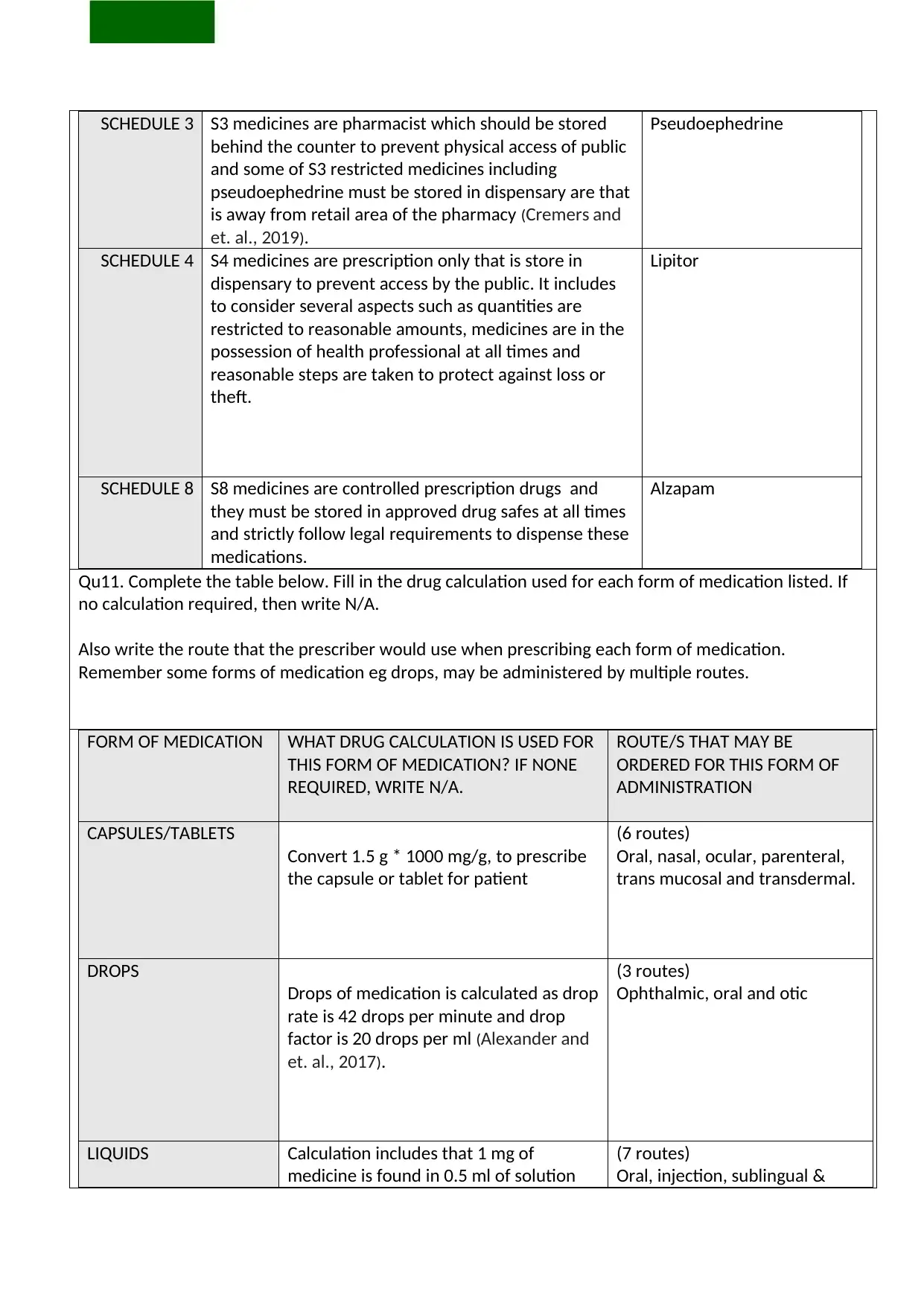
SCHEDULE 3 S3 medicines are pharmacist which should be stored
behind the counter to prevent physical access of public
and some of S3 restricted medicines including
pseudoephedrine must be stored in dispensary are that
is away from retail area of the pharmacy (Cremers and
et. al., 2019).
Pseudoephedrine
SCHEDULE 4 S4 medicines are prescription only that is store in
dispensary to prevent access by the public. It includes
to consider several aspects such as quantities are
restricted to reasonable amounts, medicines are in the
possession of health professional at all times and
reasonable steps are taken to protect against loss or
theft.
Lipitor
SCHEDULE 8 S8 medicines are controlled prescription drugs and
they must be stored in approved drug safes at all times
and strictly follow legal requirements to dispense these
medications.
Alzapam
Qu11. Complete the table below. Fill in the drug calculation used for each form of medication listed. If
no calculation required, then write N/A.
Also write the route that the prescriber would use when prescribing each form of medication.
Remember some forms of medication eg drops, may be administered by multiple routes.
FORM OF MEDICATION WHAT DRUG CALCULATION IS USED FOR
THIS FORM OF MEDICATION? IF NONE
REQUIRED, WRITE N/A.
ROUTE/S THAT MAY BE
ORDERED FOR THIS FORM OF
ADMINISTRATION
CAPSULES/TABLETS
Convert 1.5 g * 1000 mg/g, to prescribe
the capsule or tablet for patient
(6 routes)
Oral, nasal, ocular, parenteral,
trans mucosal and transdermal.
DROPS
Drops of medication is calculated as drop
rate is 42 drops per minute and drop
factor is 20 drops per ml (Alexander and
et. al., 2017).
(3 routes)
Ophthalmic, oral and otic
LIQUIDS Calculation includes that 1 mg of
medicine is found in 0.5 ml of solution
(7 routes)
Oral, injection, sublingual &
behind the counter to prevent physical access of public
and some of S3 restricted medicines including
pseudoephedrine must be stored in dispensary are that
is away from retail area of the pharmacy (Cremers and
et. al., 2019).
Pseudoephedrine
SCHEDULE 4 S4 medicines are prescription only that is store in
dispensary to prevent access by the public. It includes
to consider several aspects such as quantities are
restricted to reasonable amounts, medicines are in the
possession of health professional at all times and
reasonable steps are taken to protect against loss or
theft.
Lipitor
SCHEDULE 8 S8 medicines are controlled prescription drugs and
they must be stored in approved drug safes at all times
and strictly follow legal requirements to dispense these
medications.
Alzapam
Qu11. Complete the table below. Fill in the drug calculation used for each form of medication listed. If
no calculation required, then write N/A.
Also write the route that the prescriber would use when prescribing each form of medication.
Remember some forms of medication eg drops, may be administered by multiple routes.
FORM OF MEDICATION WHAT DRUG CALCULATION IS USED FOR
THIS FORM OF MEDICATION? IF NONE
REQUIRED, WRITE N/A.
ROUTE/S THAT MAY BE
ORDERED FOR THIS FORM OF
ADMINISTRATION
CAPSULES/TABLETS
Convert 1.5 g * 1000 mg/g, to prescribe
the capsule or tablet for patient
(6 routes)
Oral, nasal, ocular, parenteral,
trans mucosal and transdermal.
DROPS
Drops of medication is calculated as drop
rate is 42 drops per minute and drop
factor is 20 drops per ml (Alexander and
et. al., 2017).
(3 routes)
Ophthalmic, oral and otic
LIQUIDS Calculation includes that 1 mg of
medicine is found in 0.5 ml of solution
(7 routes)
Oral, injection, sublingual &
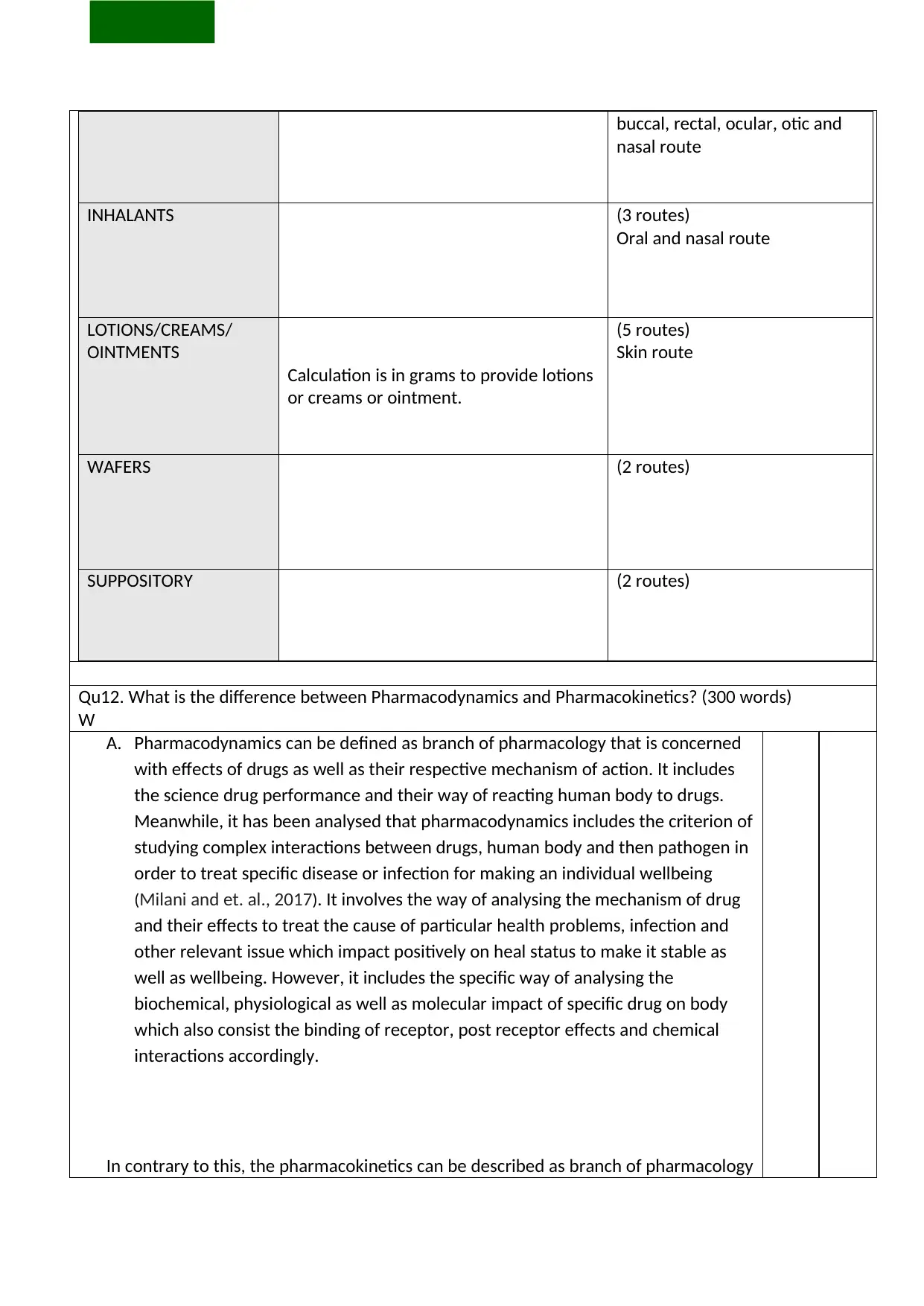
buccal, rectal, ocular, otic and
nasal route
INHALANTS (3 routes)
Oral and nasal route
LOTIONS/CREAMS/
OINTMENTS
Calculation is in grams to provide lotions
or creams or ointment.
(5 routes)
Skin route
WAFERS (2 routes)
SUPPOSITORY (2 routes)
Qu12. What is the difference between Pharmacodynamics and Pharmacokinetics? (300 words)
W
A. Pharmacodynamics can be defined as branch of pharmacology that is concerned
with effects of drugs as well as their respective mechanism of action. It includes
the science drug performance and their way of reacting human body to drugs.
Meanwhile, it has been analysed that pharmacodynamics includes the criterion of
studying complex interactions between drugs, human body and then pathogen in
order to treat specific disease or infection for making an individual wellbeing
(Milani and et. al., 2017). It involves the way of analysing the mechanism of drug
and their effects to treat the cause of particular health problems, infection and
other relevant issue which impact positively on heal status to make it stable as
well as wellbeing. However, it includes the specific way of analysing the
biochemical, physiological as well as molecular impact of specific drug on body
which also consist the binding of receptor, post receptor effects and chemical
interactions accordingly.
In contrary to this, the pharmacokinetics can be described as branch of pharmacology
nasal route
INHALANTS (3 routes)
Oral and nasal route
LOTIONS/CREAMS/
OINTMENTS
Calculation is in grams to provide lotions
or creams or ointment.
(5 routes)
Skin route
WAFERS (2 routes)
SUPPOSITORY (2 routes)
Qu12. What is the difference between Pharmacodynamics and Pharmacokinetics? (300 words)
W
A. Pharmacodynamics can be defined as branch of pharmacology that is concerned
with effects of drugs as well as their respective mechanism of action. It includes
the science drug performance and their way of reacting human body to drugs.
Meanwhile, it has been analysed that pharmacodynamics includes the criterion of
studying complex interactions between drugs, human body and then pathogen in
order to treat specific disease or infection for making an individual wellbeing
(Milani and et. al., 2017). It involves the way of analysing the mechanism of drug
and their effects to treat the cause of particular health problems, infection and
other relevant issue which impact positively on heal status to make it stable as
well as wellbeing. However, it includes the specific way of analysing the
biochemical, physiological as well as molecular impact of specific drug on body
which also consist the binding of receptor, post receptor effects and chemical
interactions accordingly.
In contrary to this, the pharmacokinetics can be described as branch of pharmacology
⊘ This is a preview!⊘
Do you want full access?
Subscribe today to unlock all pages.

Trusted by 1+ million students worldwide
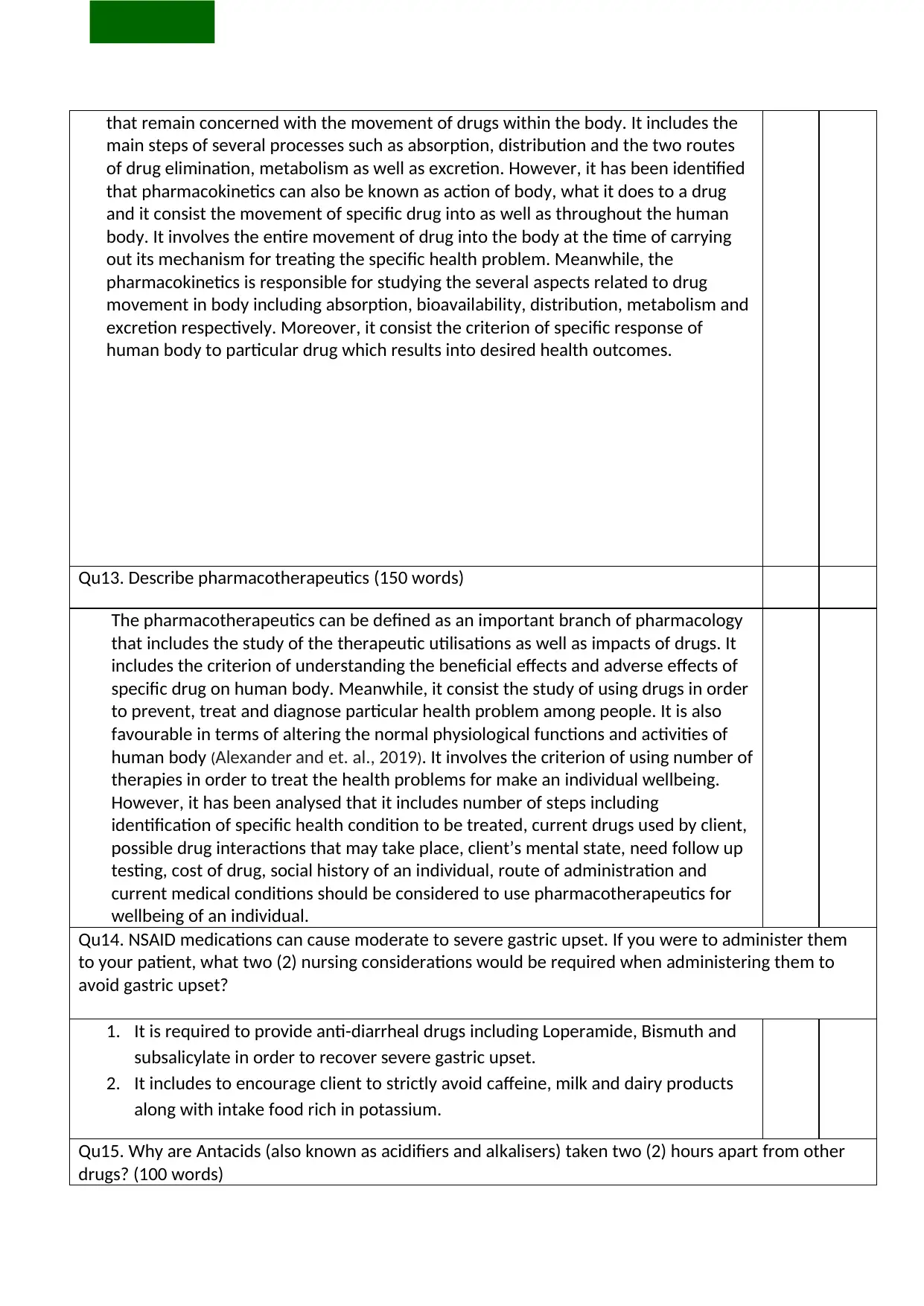
that remain concerned with the movement of drugs within the body. It includes the
main steps of several processes such as absorption, distribution and the two routes
of drug elimination, metabolism as well as excretion. However, it has been identified
that pharmacokinetics can also be known as action of body, what it does to a drug
and it consist the movement of specific drug into as well as throughout the human
body. It involves the entire movement of drug into the body at the time of carrying
out its mechanism for treating the specific health problem. Meanwhile, the
pharmacokinetics is responsible for studying the several aspects related to drug
movement in body including absorption, bioavailability, distribution, metabolism and
excretion respectively. Moreover, it consist the criterion of specific response of
human body to particular drug which results into desired health outcomes.
Qu13. Describe pharmacotherapeutics (150 words)
The pharmacotherapeutics can be defined as an important branch of pharmacology
that includes the study of the therapeutic utilisations as well as impacts of drugs. It
includes the criterion of understanding the beneficial effects and adverse effects of
specific drug on human body. Meanwhile, it consist the study of using drugs in order
to prevent, treat and diagnose particular health problem among people. It is also
favourable in terms of altering the normal physiological functions and activities of
human body (Alexander and et. al., 2019). It involves the criterion of using number of
therapies in order to treat the health problems for make an individual wellbeing.
However, it has been analysed that it includes number of steps including
identification of specific health condition to be treated, current drugs used by client,
possible drug interactions that may take place, client’s mental state, need follow up
testing, cost of drug, social history of an individual, route of administration and
current medical conditions should be considered to use pharmacotherapeutics for
wellbeing of an individual.
Qu14. NSAID medications can cause moderate to severe gastric upset. If you were to administer them
to your patient, what two (2) nursing considerations would be required when administering them to
avoid gastric upset?
1. It is required to provide anti-diarrheal drugs including Loperamide, Bismuth and
subsalicylate in order to recover severe gastric upset.
2. It includes to encourage client to strictly avoid caffeine, milk and dairy products
along with intake food rich in potassium.
Qu15. Why are Antacids (also known as acidifiers and alkalisers) taken two (2) hours apart from other
drugs? (100 words)
main steps of several processes such as absorption, distribution and the two routes
of drug elimination, metabolism as well as excretion. However, it has been identified
that pharmacokinetics can also be known as action of body, what it does to a drug
and it consist the movement of specific drug into as well as throughout the human
body. It involves the entire movement of drug into the body at the time of carrying
out its mechanism for treating the specific health problem. Meanwhile, the
pharmacokinetics is responsible for studying the several aspects related to drug
movement in body including absorption, bioavailability, distribution, metabolism and
excretion respectively. Moreover, it consist the criterion of specific response of
human body to particular drug which results into desired health outcomes.
Qu13. Describe pharmacotherapeutics (150 words)
The pharmacotherapeutics can be defined as an important branch of pharmacology
that includes the study of the therapeutic utilisations as well as impacts of drugs. It
includes the criterion of understanding the beneficial effects and adverse effects of
specific drug on human body. Meanwhile, it consist the study of using drugs in order
to prevent, treat and diagnose particular health problem among people. It is also
favourable in terms of altering the normal physiological functions and activities of
human body (Alexander and et. al., 2019). It involves the criterion of using number of
therapies in order to treat the health problems for make an individual wellbeing.
However, it has been analysed that it includes number of steps including
identification of specific health condition to be treated, current drugs used by client,
possible drug interactions that may take place, client’s mental state, need follow up
testing, cost of drug, social history of an individual, route of administration and
current medical conditions should be considered to use pharmacotherapeutics for
wellbeing of an individual.
Qu14. NSAID medications can cause moderate to severe gastric upset. If you were to administer them
to your patient, what two (2) nursing considerations would be required when administering them to
avoid gastric upset?
1. It is required to provide anti-diarrheal drugs including Loperamide, Bismuth and
subsalicylate in order to recover severe gastric upset.
2. It includes to encourage client to strictly avoid caffeine, milk and dairy products
along with intake food rich in potassium.
Qu15. Why are Antacids (also known as acidifiers and alkalisers) taken two (2) hours apart from other
drugs? (100 words)
Paraphrase This Document
Need a fresh take? Get an instant paraphrase of this document with our AI Paraphraser
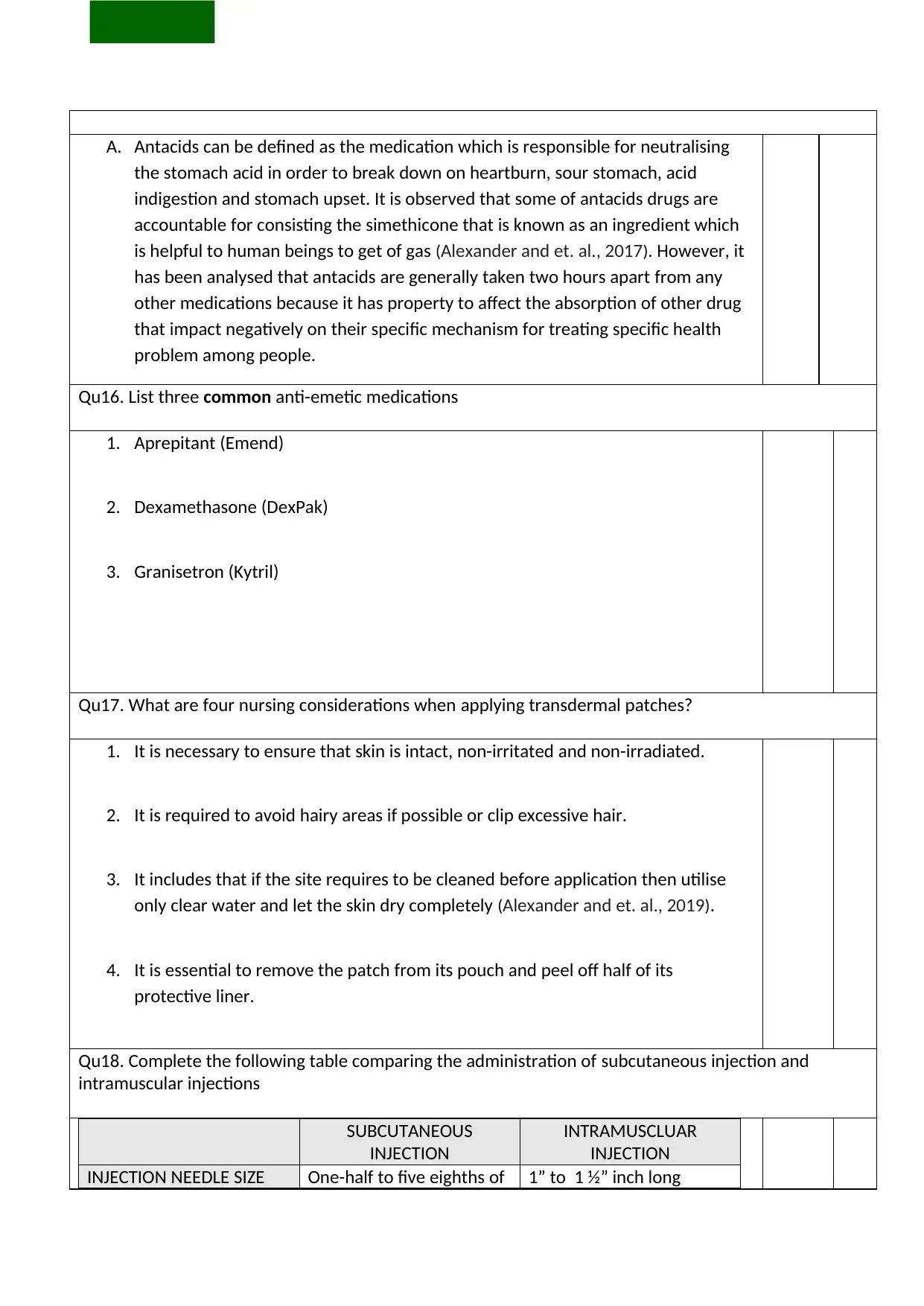
A. Antacids can be defined as the medication which is responsible for neutralising
the stomach acid in order to break down on heartburn, sour stomach, acid
indigestion and stomach upset. It is observed that some of antacids drugs are
accountable for consisting the simethicone that is known as an ingredient which
is helpful to human beings to get of gas (Alexander and et. al., 2017). However, it
has been analysed that antacids are generally taken two hours apart from any
other medications because it has property to affect the absorption of other drug
that impact negatively on their specific mechanism for treating specific health
problem among people.
Qu16. List three common anti-emetic medications
1. Aprepitant (Emend)
2. Dexamethasone (DexPak)
3. Granisetron (Kytril)
Qu17. What are four nursing considerations when applying transdermal patches?
1. It is necessary to ensure that skin is intact, non-irritated and non-irradiated.
2. It is required to avoid hairy areas if possible or clip excessive hair.
3. It includes that if the site requires to be cleaned before application then utilise
only clear water and let the skin dry completely (Alexander and et. al., 2019).
4. It is essential to remove the patch from its pouch and peel off half of its
protective liner.
Qu18. Complete the following table comparing the administration of subcutaneous injection and
intramuscular injections
SUBCUTANEOUS
INJECTION
INTRAMUSCLUAR
INJECTION
INJECTION NEEDLE SIZE One-half to five eighths of 1” to 1 ½” inch long
the stomach acid in order to break down on heartburn, sour stomach, acid
indigestion and stomach upset. It is observed that some of antacids drugs are
accountable for consisting the simethicone that is known as an ingredient which
is helpful to human beings to get of gas (Alexander and et. al., 2017). However, it
has been analysed that antacids are generally taken two hours apart from any
other medications because it has property to affect the absorption of other drug
that impact negatively on their specific mechanism for treating specific health
problem among people.
Qu16. List three common anti-emetic medications
1. Aprepitant (Emend)
2. Dexamethasone (DexPak)
3. Granisetron (Kytril)
Qu17. What are four nursing considerations when applying transdermal patches?
1. It is necessary to ensure that skin is intact, non-irritated and non-irradiated.
2. It is required to avoid hairy areas if possible or clip excessive hair.
3. It includes that if the site requires to be cleaned before application then utilise
only clear water and let the skin dry completely (Alexander and et. al., 2019).
4. It is essential to remove the patch from its pouch and peel off half of its
protective liner.
Qu18. Complete the following table comparing the administration of subcutaneous injection and
intramuscular injections
SUBCUTANEOUS
INJECTION
INTRAMUSCLUAR
INJECTION
INJECTION NEEDLE SIZE One-half to five eighths of 1” to 1 ½” inch long
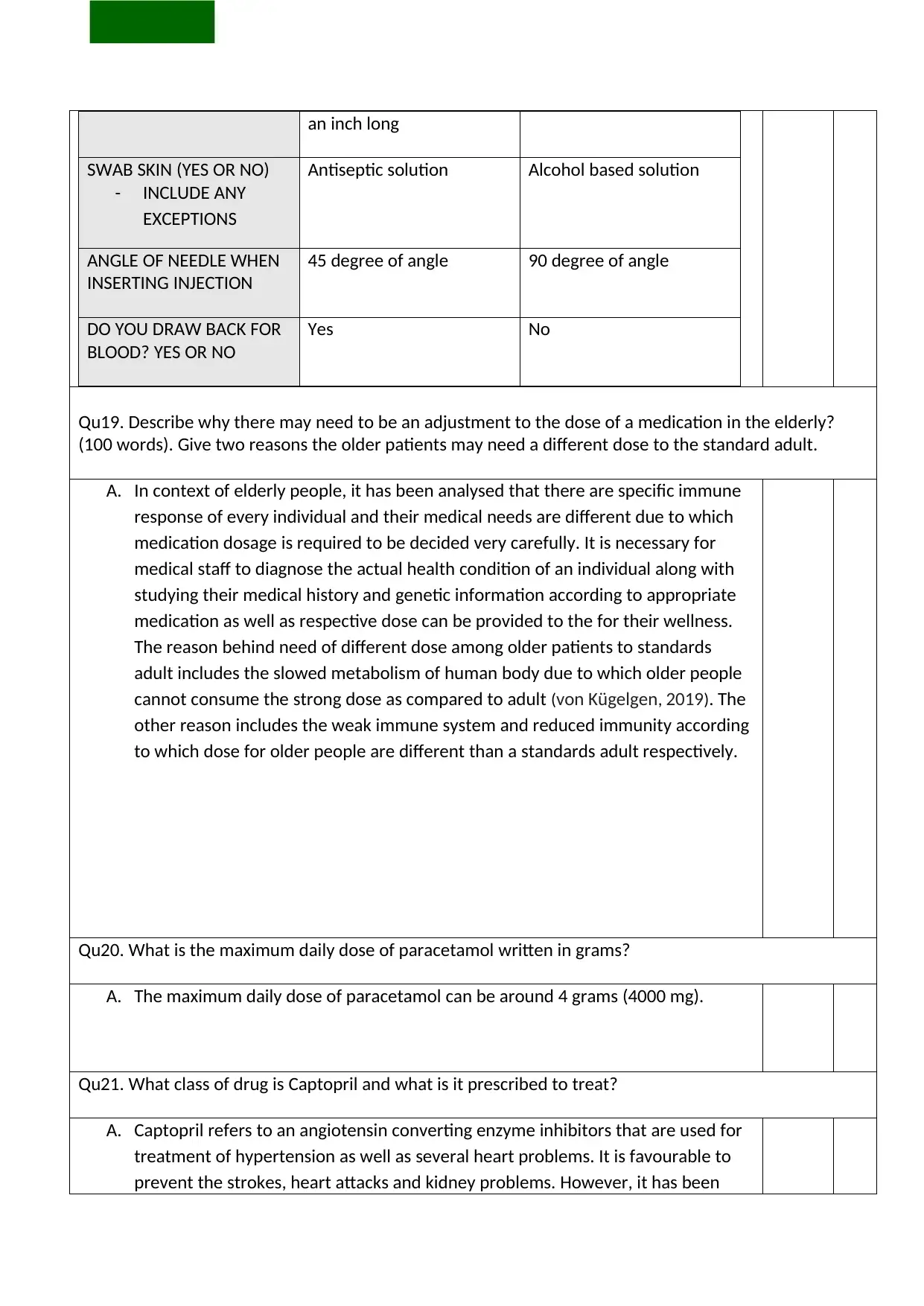
an inch long
SWAB SKIN (YES OR NO)
- INCLUDE ANY
EXCEPTIONS
Antiseptic solution Alcohol based solution
ANGLE OF NEEDLE WHEN
INSERTING INJECTION
45 degree of angle 90 degree of angle
DO YOU DRAW BACK FOR
BLOOD? YES OR NO
Yes No
Qu19. Describe why there may need to be an adjustment to the dose of a medication in the elderly?
(100 words). Give two reasons the older patients may need a different dose to the standard adult.
A. In context of elderly people, it has been analysed that there are specific immune
response of every individual and their medical needs are different due to which
medication dosage is required to be decided very carefully. It is necessary for
medical staff to diagnose the actual health condition of an individual along with
studying their medical history and genetic information according to appropriate
medication as well as respective dose can be provided to the for their wellness.
The reason behind need of different dose among older patients to standards
adult includes the slowed metabolism of human body due to which older people
cannot consume the strong dose as compared to adult (von Kügelgen, 2019). The
other reason includes the weak immune system and reduced immunity according
to which dose for older people are different than a standards adult respectively.
Qu20. What is the maximum daily dose of paracetamol written in grams?
A. The maximum daily dose of paracetamol can be around 4 grams (4000 mg).
Qu21. What class of drug is Captopril and what is it prescribed to treat?
A. Captopril refers to an angiotensin converting enzyme inhibitors that are used for
treatment of hypertension as well as several heart problems. It is favourable to
prevent the strokes, heart attacks and kidney problems. However, it has been
SWAB SKIN (YES OR NO)
- INCLUDE ANY
EXCEPTIONS
Antiseptic solution Alcohol based solution
ANGLE OF NEEDLE WHEN
INSERTING INJECTION
45 degree of angle 90 degree of angle
DO YOU DRAW BACK FOR
BLOOD? YES OR NO
Yes No
Qu19. Describe why there may need to be an adjustment to the dose of a medication in the elderly?
(100 words). Give two reasons the older patients may need a different dose to the standard adult.
A. In context of elderly people, it has been analysed that there are specific immune
response of every individual and their medical needs are different due to which
medication dosage is required to be decided very carefully. It is necessary for
medical staff to diagnose the actual health condition of an individual along with
studying their medical history and genetic information according to appropriate
medication as well as respective dose can be provided to the for their wellness.
The reason behind need of different dose among older patients to standards
adult includes the slowed metabolism of human body due to which older people
cannot consume the strong dose as compared to adult (von Kügelgen, 2019). The
other reason includes the weak immune system and reduced immunity according
to which dose for older people are different than a standards adult respectively.
Qu20. What is the maximum daily dose of paracetamol written in grams?
A. The maximum daily dose of paracetamol can be around 4 grams (4000 mg).
Qu21. What class of drug is Captopril and what is it prescribed to treat?
A. Captopril refers to an angiotensin converting enzyme inhibitors that are used for
treatment of hypertension as well as several heart problems. It is favourable to
prevent the strokes, heart attacks and kidney problems. However, it has been
⊘ This is a preview!⊘
Do you want full access?
Subscribe today to unlock all pages.

Trusted by 1+ million students worldwide
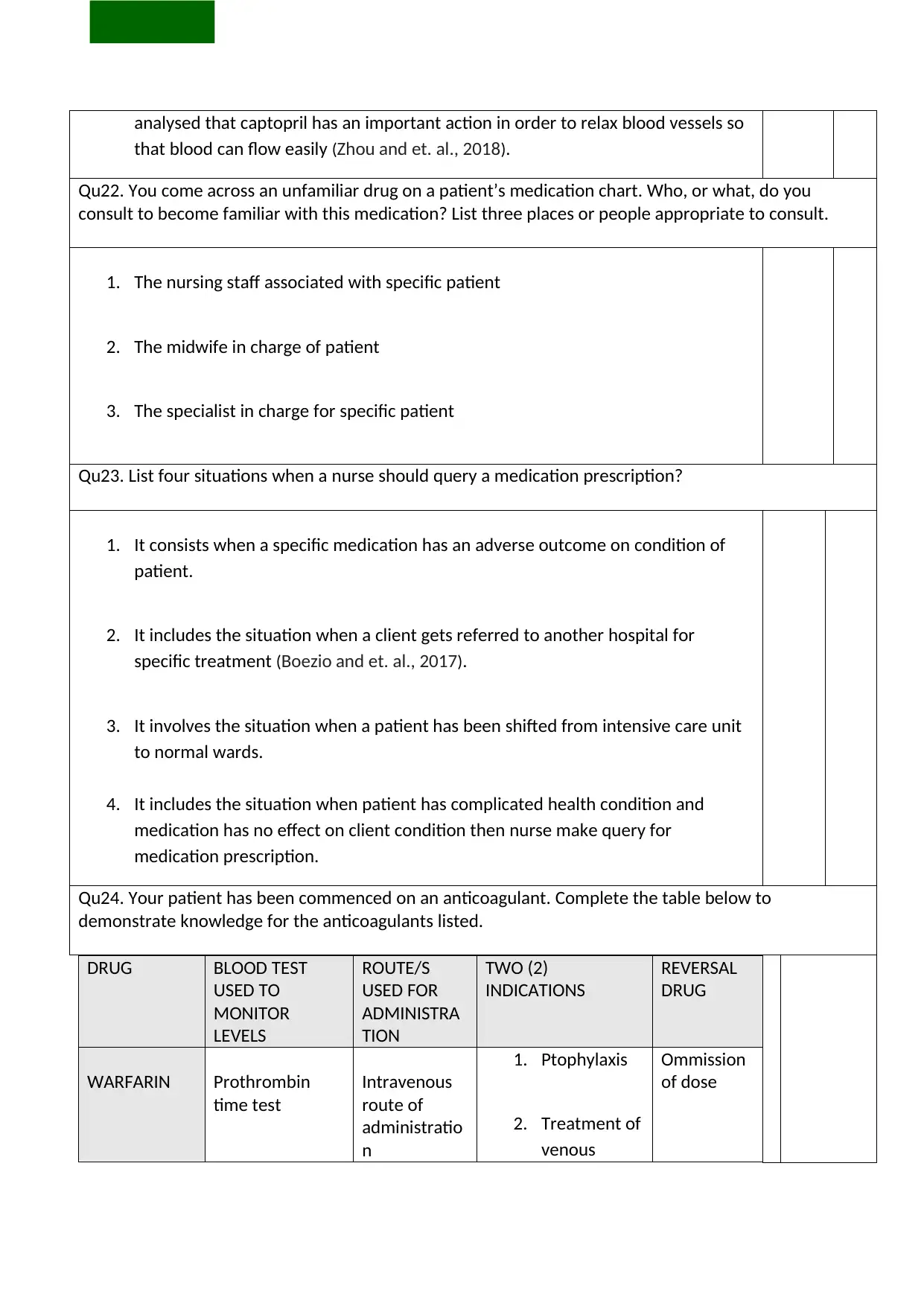
analysed that captopril has an important action in order to relax blood vessels so
that blood can flow easily (Zhou and et. al., 2018).
Qu22. You come across an unfamiliar drug on a patient’s medication chart. Who, or what, do you
consult to become familiar with this medication? List three places or people appropriate to consult.
1. The nursing staff associated with specific patient
2. The midwife in charge of patient
3. The specialist in charge for specific patient
Qu23. List four situations when a nurse should query a medication prescription?
1. It consists when a specific medication has an adverse outcome on condition of
patient.
2. It includes the situation when a client gets referred to another hospital for
specific treatment (Boezio and et. al., 2017).
3. It involves the situation when a patient has been shifted from intensive care unit
to normal wards.
4. It includes the situation when patient has complicated health condition and
medication has no effect on client condition then nurse make query for
medication prescription.
Qu24. Your patient has been commenced on an anticoagulant. Complete the table below to
demonstrate knowledge for the anticoagulants listed.
DRUG BLOOD TEST
USED TO
MONITOR
LEVELS
ROUTE/S
USED FOR
ADMINISTRA
TION
TWO (2)
INDICATIONS
REVERSAL
DRUG
WARFARIN Prothrombin
time test
Intravenous
route of
administratio
n
1. Ptophylaxis
2. Treatment of
venous
Ommission
of dose
that blood can flow easily (Zhou and et. al., 2018).
Qu22. You come across an unfamiliar drug on a patient’s medication chart. Who, or what, do you
consult to become familiar with this medication? List three places or people appropriate to consult.
1. The nursing staff associated with specific patient
2. The midwife in charge of patient
3. The specialist in charge for specific patient
Qu23. List four situations when a nurse should query a medication prescription?
1. It consists when a specific medication has an adverse outcome on condition of
patient.
2. It includes the situation when a client gets referred to another hospital for
specific treatment (Boezio and et. al., 2017).
3. It involves the situation when a patient has been shifted from intensive care unit
to normal wards.
4. It includes the situation when patient has complicated health condition and
medication has no effect on client condition then nurse make query for
medication prescription.
Qu24. Your patient has been commenced on an anticoagulant. Complete the table below to
demonstrate knowledge for the anticoagulants listed.
DRUG BLOOD TEST
USED TO
MONITOR
LEVELS
ROUTE/S
USED FOR
ADMINISTRA
TION
TWO (2)
INDICATIONS
REVERSAL
DRUG
WARFARIN Prothrombin
time test
Intravenous
route of
administratio
n
1. Ptophylaxis
2. Treatment of
venous
Ommission
of dose
Paraphrase This Document
Need a fresh take? Get an instant paraphrase of this document with our AI Paraphraser
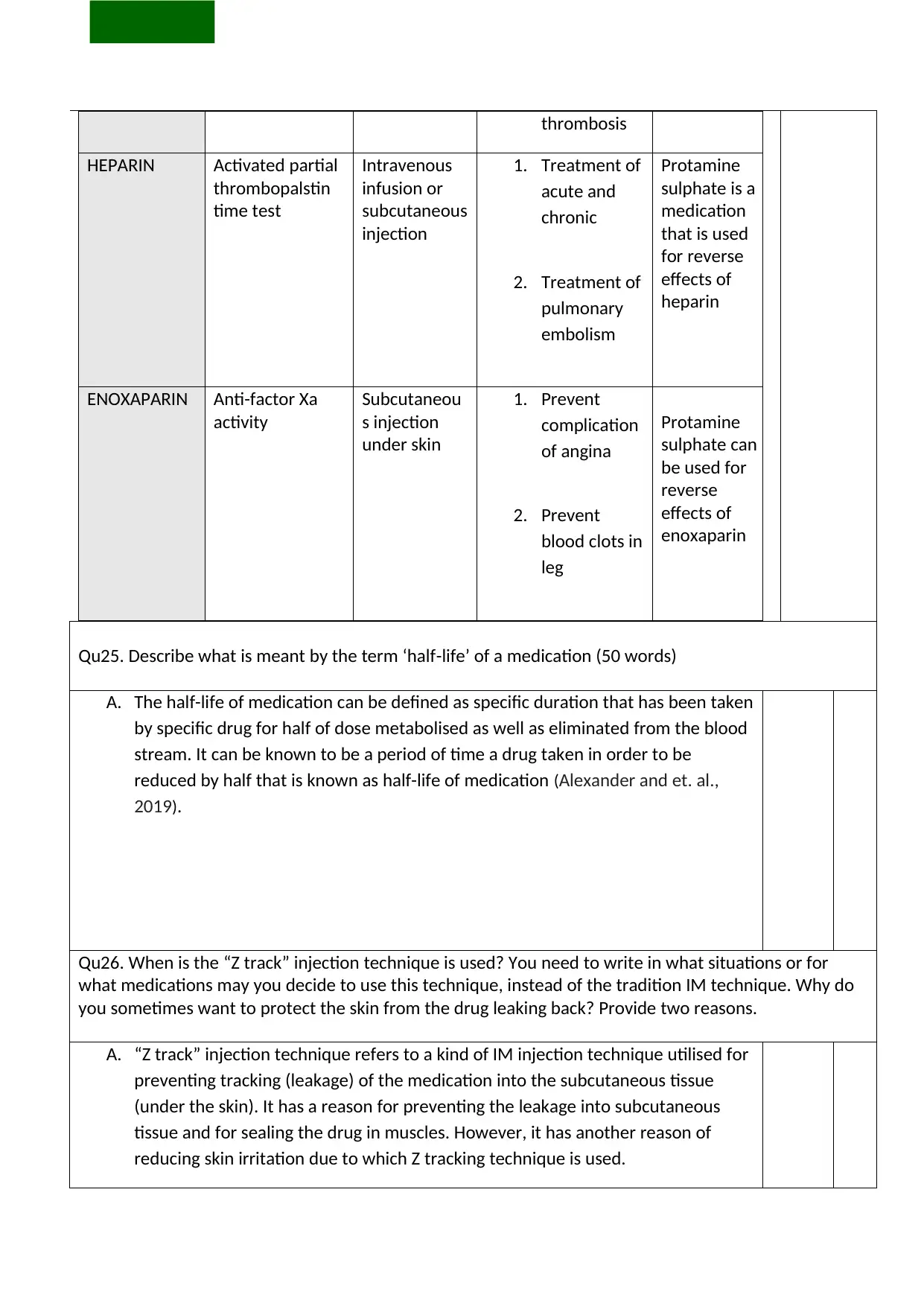
thrombosis
HEPARIN Activated partial
thrombopalstin
time test
Intravenous
infusion or
subcutaneous
injection
1. Treatment of
acute and
chronic
2. Treatment of
pulmonary
embolism
Protamine
sulphate is a
medication
that is used
for reverse
effects of
heparin
ENOXAPARIN Anti-factor Xa
activity
Subcutaneou
s injection
under skin
1. Prevent
complication
of angina
2. Prevent
blood clots in
leg
Protamine
sulphate can
be used for
reverse
effects of
enoxaparin
Qu25. Describe what is meant by the term ‘half-life’ of a medication (50 words)
A. The half-life of medication can be defined as specific duration that has been taken
by specific drug for half of dose metabolised as well as eliminated from the blood
stream. It can be known to be a period of time a drug taken in order to be
reduced by half that is known as half-life of medication (Alexander and et. al.,
2019).
Qu26. When is the “Z track” injection technique is used? You need to write in what situations or for
what medications may you decide to use this technique, instead of the tradition IM technique. Why do
you sometimes want to protect the skin from the drug leaking back? Provide two reasons.
A. “Z track” injection technique refers to a kind of IM injection technique utilised for
preventing tracking (leakage) of the medication into the subcutaneous tissue
(under the skin). It has a reason for preventing the leakage into subcutaneous
tissue and for sealing the drug in muscles. However, it has another reason of
reducing skin irritation due to which Z tracking technique is used.
HEPARIN Activated partial
thrombopalstin
time test
Intravenous
infusion or
subcutaneous
injection
1. Treatment of
acute and
chronic
2. Treatment of
pulmonary
embolism
Protamine
sulphate is a
medication
that is used
for reverse
effects of
heparin
ENOXAPARIN Anti-factor Xa
activity
Subcutaneou
s injection
under skin
1. Prevent
complication
of angina
2. Prevent
blood clots in
leg
Protamine
sulphate can
be used for
reverse
effects of
enoxaparin
Qu25. Describe what is meant by the term ‘half-life’ of a medication (50 words)
A. The half-life of medication can be defined as specific duration that has been taken
by specific drug for half of dose metabolised as well as eliminated from the blood
stream. It can be known to be a period of time a drug taken in order to be
reduced by half that is known as half-life of medication (Alexander and et. al.,
2019).
Qu26. When is the “Z track” injection technique is used? You need to write in what situations or for
what medications may you decide to use this technique, instead of the tradition IM technique. Why do
you sometimes want to protect the skin from the drug leaking back? Provide two reasons.
A. “Z track” injection technique refers to a kind of IM injection technique utilised for
preventing tracking (leakage) of the medication into the subcutaneous tissue
(under the skin). It has a reason for preventing the leakage into subcutaneous
tissue and for sealing the drug in muscles. However, it has another reason of
reducing skin irritation due to which Z tracking technique is used.
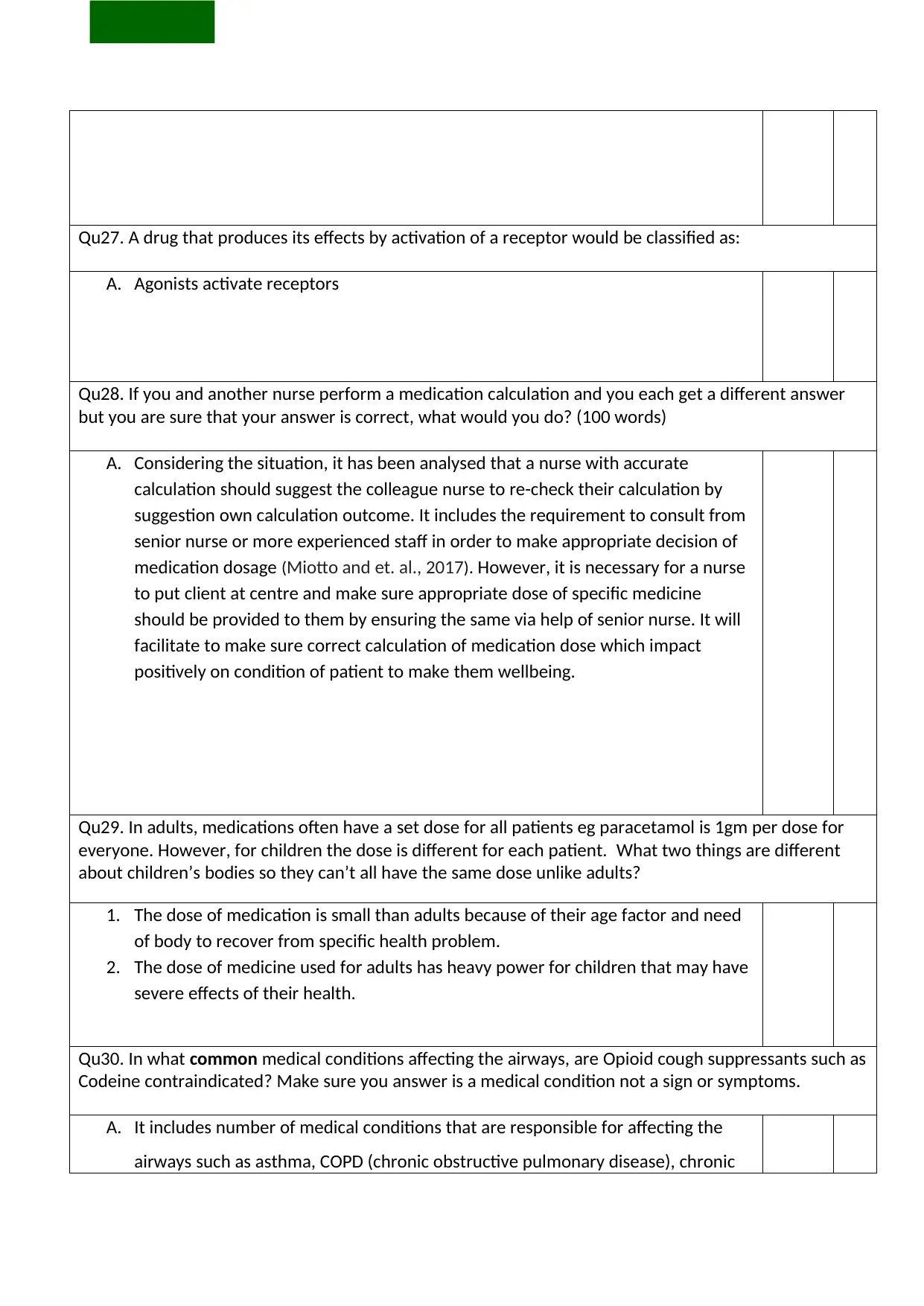
Qu27. A drug that produces its effects by activation of a receptor would be classified as:
A. Agonists activate receptors
Qu28. If you and another nurse perform a medication calculation and you each get a different answer
but you are sure that your answer is correct, what would you do? (100 words)
A. Considering the situation, it has been analysed that a nurse with accurate
calculation should suggest the colleague nurse to re-check their calculation by
suggestion own calculation outcome. It includes the requirement to consult from
senior nurse or more experienced staff in order to make appropriate decision of
medication dosage (Miotto and et. al., 2017). However, it is necessary for a nurse
to put client at centre and make sure appropriate dose of specific medicine
should be provided to them by ensuring the same via help of senior nurse. It will
facilitate to make sure correct calculation of medication dose which impact
positively on condition of patient to make them wellbeing.
Qu29. In adults, medications often have a set dose for all patients eg paracetamol is 1gm per dose for
everyone. However, for children the dose is different for each patient. What two things are different
about children’s bodies so they can’t all have the same dose unlike adults?
1. The dose of medication is small than adults because of their age factor and need
of body to recover from specific health problem.
2. The dose of medicine used for adults has heavy power for children that may have
severe effects of their health.
Qu30. In what common medical conditions affecting the airways, are Opioid cough suppressants such as
Codeine contraindicated? Make sure you answer is a medical condition not a sign or symptoms.
A. It includes number of medical conditions that are responsible for affecting the
airways such as asthma, COPD (chronic obstructive pulmonary disease), chronic
A. Agonists activate receptors
Qu28. If you and another nurse perform a medication calculation and you each get a different answer
but you are sure that your answer is correct, what would you do? (100 words)
A. Considering the situation, it has been analysed that a nurse with accurate
calculation should suggest the colleague nurse to re-check their calculation by
suggestion own calculation outcome. It includes the requirement to consult from
senior nurse or more experienced staff in order to make appropriate decision of
medication dosage (Miotto and et. al., 2017). However, it is necessary for a nurse
to put client at centre and make sure appropriate dose of specific medicine
should be provided to them by ensuring the same via help of senior nurse. It will
facilitate to make sure correct calculation of medication dose which impact
positively on condition of patient to make them wellbeing.
Qu29. In adults, medications often have a set dose for all patients eg paracetamol is 1gm per dose for
everyone. However, for children the dose is different for each patient. What two things are different
about children’s bodies so they can’t all have the same dose unlike adults?
1. The dose of medication is small than adults because of their age factor and need
of body to recover from specific health problem.
2. The dose of medicine used for adults has heavy power for children that may have
severe effects of their health.
Qu30. In what common medical conditions affecting the airways, are Opioid cough suppressants such as
Codeine contraindicated? Make sure you answer is a medical condition not a sign or symptoms.
A. It includes number of medical conditions that are responsible for affecting the
airways such as asthma, COPD (chronic obstructive pulmonary disease), chronic
⊘ This is a preview!⊘
Do you want full access?
Subscribe today to unlock all pages.

Trusted by 1+ million students worldwide
1 out of 27
Related Documents
Your All-in-One AI-Powered Toolkit for Academic Success.
+13062052269
info@desklib.com
Available 24*7 on WhatsApp / Email
![[object Object]](/_next/static/media/star-bottom.7253800d.svg)
Unlock your academic potential
Copyright © 2020–2025 A2Z Services. All Rights Reserved. Developed and managed by ZUCOL.





